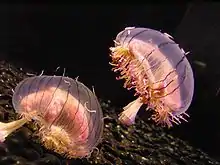Flower hat jelly
The flower hat jelly (Olindias formosus) is a species of hydromedusa in the hydrozoan family Olindiidae. Although they look like a jellyfish, they actually belong in the class Hydrozoa, while true jellyfish belong in class Scyphozoa. Flower hat jellies occur in the northwestern Pacific off central and southern Japan, and South Korea's Jeju Island.[3] (close relatives live elsewhere, like O. sambaquiensis found off Argentina and Brazil).[4] The adult form of the flower hat jelly only lives a few months and is typically seen from December to July, with peaks in April and May.[3] During the day they rest on the bottom, often among rocks or algae, but at night they float up to hunt for their prey,[3] typically small fish.[5]
| Flower hat jelly | |
|---|---|
 | |
| Scientific classification | |
| Domain: | Eukaryota |
| Kingdom: | Animalia |
| Phylum: | Cnidaria |
| Class: | Hydrozoa |
| Order: | Limnomedusae |
| Family: | Olindiidae |
| Genus: | Olindias |
| Species: | O. formosus |
| Binomial name | |
| Olindias formosus | |
| Synonyms | |
| |
The sting of the flower hat jelly is generally mildly painful and leaves a rash.[3][5] There is a single known human fatality from Japan.[3]
Appearance and life cycle


This fluorescent jelly has lustrous tentacles that coil and adhere to its rim when not in use. Its bell is translucent and pinstriped with opaque bands. Although the tentacles may look randomized in their arrangement, extensive research has been done to show that the tentacles are arranged mathematically. The tentacle arrangement displays an optimal hashing algorithm. This is called the Fibonacci hashing. [6]
The flower hat jelly can grow to be about 15 cm (6 in) in diameter.[5] When first observed in the wild, typically around December, they only measure 2 cm (0.8 in).[3]
Little is known about the details of its life cycle and no Olindias hydroids have been reported from the wild. Flower hat jellies have bred in a display at the Monterey Bay Aquarium. The hydroids attached themselves to various surfaces and formed small clusters. Eventually the medusae were released at a diameter of about 1 mm (0.04 in). Budding only happened when the hydroids were kept at water temperatures of 15 °C (59 °F); not 20 °C (68 °F) or 25 °C (77 °F). In contrast, the two warmer temperatures appeared to produce more medusae. This indicates that hydroid growth and reproduction (budding) occur in 15 °C (59 °F) or less, while warmer temperatures initiate the change into medusae. This matches the annual sea temperature variations observed in its native range. In aquariums, adults are usually kept in full salt water that is about 15–18 °C (59–64 °F).[3]
References
- Olindias formosus. Retrieved through: World Register of Marine Species.
- Goto, S. (1903). The craspedote medusa Olindias and some of its natural allies. In: Mark Anniversary Volume, 1903, p. 1–22. The full text
- Patry, W.; T. Knowles; L. Christianson; M. Howard (2014). The hydroid and early medusa stage of Olindias formosus (Cnidaria, Hydrozoa, Limnomedusae). Journal of the Marine Biological Association of the United Kingdom 94(7): 1409–1415. doi:10.1017/S0025315414000691
- Resgalla Junior, C.; A.L. Rosseto; V. Haddad Jr (2011). Report of an outbreak of stings caused by Olindias sambaquiensis Muller, 1861 (Cnidaria: hydrozoa) in Southern Brazil. Braz. j. oceanogr. 59(4). doi:10.1590/S1679-87592011000400009
- Monterey Bay Aquarium: Flower hat jelly. Retrieved 17 March 2019.
- Okabe, Takuya; Yoshimura, Jin (2016-06-07). "Optimal hash arrangement of tentacles in jellyfish". Scientific Reports. 6 (1): 27347. doi:10.1038/srep27347. ISSN 2045-2322.